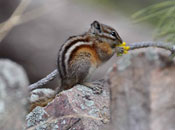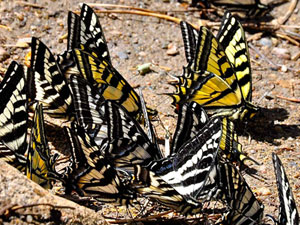Wildlife at Eldorado Canyon
 Mule deer, elk, black bear, bobcat, red fox, coyote and mountain lion inhabit the foothills in and around Eldorado Canyon. Riparian habitats in the park serve as movement corridors for these animals. Large populations of bats breed in the caves in the Inner Canyon. Seven out of ten bat species recorded in Boulder County occur in the park. South Boulder Creek supports cold-water fish species, including rainbow, brook, and brown trout, longnose dace, and white and longnose suckers.
Mule deer, elk, black bear, bobcat, red fox, coyote and mountain lion inhabit the foothills in and around Eldorado Canyon. Riparian habitats in the park serve as movement corridors for these animals. Large populations of bats breed in the caves in the Inner Canyon. Seven out of ten bat species recorded in Boulder County occur in the park. South Boulder Creek supports cold-water fish species, including rainbow, brook, and brown trout, longnose dace, and white and longnose suckers.
Over eighty species of migratory and resident birds have been recorded for this area including raptors, songbirds and waterfowl. Golden eagles, red-tailed hawks and prairie falcons nest within and around the park; seasonal closures of some climbing routes is enforced to protect raptor nesting sites. Sightings of wild turkeys and blue grouse occur in Crescent Meadows and American dippers may be seen along streams.
See the Eldorado Canyon Bird Checklist.
Plants at Eldorado Canyon
 Eldorado Canyon State Park includes 1,488 acres located in the unique ecological zone between the grasslands of the plains and the forests of Front Range foothills. The two main areas in the park are the Inner Canyon and Crescent Meadows. Elevations range from 5,800 and 8,800 feet.
Eldorado Canyon State Park includes 1,488 acres located in the unique ecological zone between the grasslands of the plains and the forests of Front Range foothills. The two main areas in the park are the Inner Canyon and Crescent Meadows. Elevations range from 5,800 and 8,800 feet.
Eldorado exemplifies the diversity of vegetation types found in Colorado’s Front Range foothills. Many factors attribute to this diversity, including the park’s varied topography, soils, microclimates of the canyon and, specifically, its location in the ecotone between mixed grass prairie and montane woodland. Vegetation communities at Eldorado are the following:
- Douglas-fir forest
- Ponderosa pine savanna
- Mixed grass prairie
- Northern riparian forest
- Riparian shrubland
- Mixed foothill shrubland
Nearly barren rock outcrops and cliffs support lichen and moss communities. Ponderosa pine and Rocky Mountain juniper are the dominant trees, commonly associated species include mountain mahogany, skunkbrush, currant, kinnikinnick, goldaster and beard-tongue. Dominant grass species include little bluestem, blue and side-oats grama, needle-and-thread grass, pine dropseed, prairie Junegrass, western wheatgrass, purple three-awn and smooth brome. One rare plant association, Douglas-fir/river birch, occurs in the northeast corner of Crescent Meadows.  Riparian and wetland communities, though limited, are found along South Boulder Creek tributary drainages and on seeps and springs. Plains and narrowleaf cottonwood, Rocky Mountain maple, boxelder, chokecherry and American plum dominate riparian communities. Wetland communities are characterized by a number of shrubby willow species, Nebraska and aquatic sedge, Arctic rush and grass species.
Riparian and wetland communities, though limited, are found along South Boulder Creek tributary drainages and on seeps and springs. Plains and narrowleaf cottonwood, Rocky Mountain maple, boxelder, chokecherry and American plum dominate riparian communities. Wetland communities are characterized by a number of shrubby willow species, Nebraska and aquatic sedge, Arctic rush and grass species.

